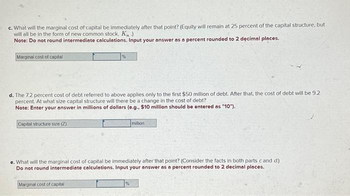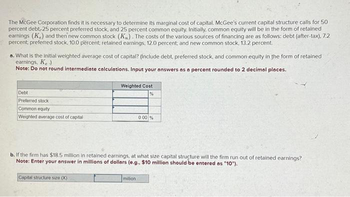
Essentials Of Investments
11th Edition
ISBN: 9781260013924
Author: Bodie, Zvi, Kane, Alex, MARCUS, Alan J.
Publisher: Mcgraw-hill Education,
expand_more
expand_more
format_list_bulleted
Concept explainers
Topic Video
Question

Transcribed Image Text:c. What will the marginal cost of capital be immediately after that point? (Equity will remain at 25 percent of the capital structure, but
will all be in the form of new common stock, K₁ )
Note: Do not round intermediate calculations. Input your answer as a percent rounded to 2 decimal places.
Marginal cost of capital
d. The 7.2 percent cost of debt referred to above applies only to the first $50 million of debt. After that, the cost of debt will be 9.2
percent. At what size capital structure will there be a change in the cost of debt?
Note: Enter your answer in millions of dollars (e.g., $10 million should be entered as "10").
Capital structure size (Z)
million
e. What will the marginal cost of capital be immediately after that point? (Consider the facts in both parts cand d.)
Do not round intermediate calculations. Input your answer as a percent rounded to 2 decimal places.
Marginal cost of capital

Transcribed Image Text:The McGee Corporation finds it is necessary to determine its marginal cost of capital. McGee's current capital structure calls for 50
percent debt, 25 percent preferred stock, and 25 percent common equity. Initially, common equity will be in the form of retained
earnings (K) and then new common stock (K). The costs of the various sources of financing are as follows: debt (after-tax), 7.2
percent; preferred stock, 10.0 percent, retained earnings, 12.0 percent; and new common stock, 13.2 percent.
a. What is the initial weighted average cost of capital? (Include debt, preferred stock, and common equity in the form of retained
earnings, K.)
Note: Do not round intermediate calculations. Input your answers as a percent rounded to 2 decimal places.
Debt
Preferred stock
Common equity
Weighted average cost of capital
Weighted Cost
%
Capital structure size (X)
b. If the firm has $18.5 million in retained earnings, at what size capital structure will the firm run out of retained earnings?
Note: Enter your answer in millions of dollars (e.g., $10 million should be entered as "10").
0.00%
million
Expert Solution
This question has been solved!
Explore an expertly crafted, step-by-step solution for a thorough understanding of key concepts.
This is a popular solution
Trending nowThis is a popular solution!
Step by stepSolved in 3 steps with 2 images

Knowledge Booster
Learn more about
Need a deep-dive on the concept behind this application? Look no further. Learn more about this topic, finance and related others by exploring similar questions and additional content below.Similar questions
- Need answer pleasearrow_forwardc. What will the marginal cost of capital be immediately after that point? (Equity will remain at 45 percent of the capital structure, but will all be in the form of new common stock, Kn.) Note: Do not round intermediate calculations. Input your answer as a percent rounded to 2 decimal places. Marginal cost of capital % d. The 5.0 percent cost of debt referred to above applies only to the first $36 million of debt. After that, the cost of debt will be 8.5 percent. At what size capital structure will there be a change in the cost of debt? Note: Enter your answer in millions of dollars (e.g., $10 million should be entered as "10"). Capital structure size (Z) million e. What will the marginal cost of capital be immediately after that point? (Consider the facts in both parts cand d.) Do not round intermediate calculations. Input your answer as a percent rounded to 2 decimal places. Marginal cost of capital %arrow_forwardAssume the firm has a tax rate of 23 percent. c-1. Calculate return on equity (ROE) under each of the three economic scenarios before any debt is Issued. (Do not round Intermediate calculations and enter your answers as a percent rounded to 2 decimal places, e.g., 32.16.) c-2. Calculate the percentage changes in ROE when the economy expands or enters a recession. (A negative answer should be indicated by a minus sign. Do not round Intermediate calculations and enter your answers as a percent rounded to 2 decimal places, e.g., 32.16.) c-3. Calculate the return on equity (ROE) under each of the three economic scenarios assuming the firm goes through with the recapitalization. (Do not round Intermediate calculations and enter your answers as a percent rounded to 2 decimal places, e.g., 32.16.) c-4. Given the recapitalization, calculate the percentage changes in ROE when the economy expands or enters a recession. (A negative answer should be indicated by a minus sign. Do not round…arrow_forward
- Assume Skyler Industries has debt of $4,950,000 with a cost of capital of 7.2% and equity of $4,950,000 with a cost of capital of 10.8%. What is Skyler’s weighted average cost of capital? Round your intermediate calculations and final answer to 3 decimal places.arrow_forwardThe Taylor Company has an ROA of 9.1 percent, a profit margin of 10.5 percent, and an ROE of 16.5 percent. What is the company's total asset turnover? Do not round intermediate calculations and round your answer to 2 decimal places, e.g 32.16. What is the equity multiplier? Note: Do not round intermediate calculations and round your answer to 2 decimal places, e.g., 32.16.arrow_forwardEvans Technology has the following capital structure. Debt Common equity 35% 65 The aftertax cost of debt is 7.50 percent, and the cost of common equity (in the form of retained earnings) is 14.50 percent. a. What is the firm's weighted average cost of capital? Note: Do not round intermediate calculations. Input your answers as a percent rounded to 2 decimal places. Debt Common equity Weighted average cost of capital Weighted Cost % % An outside consultant has suggested that because debt is cheaper than equity, the firm should switch to a capital structure that is 50 percent debt and 50 percent equity. Under this new and more debt-oriented arrangement, the aftertax cost of debt is 8.50 percent, and the cost of common equity (in the form of retained earnings) is 16.50 percent. Debt Common equity Weighted average cost of capital b. Recalculate the firm's weighted average cost of capital. Note: Do not round intermediate calculations. Input your answers as a percent rounded to 2 decimal…arrow_forward
- Question: Fama's Llamas has a weighted average cost of capital of 9.5%. The company's cost of equity is 11%, and its cost of debt is 7.5%. The tax rate is 40%. What is the company's debt- equity ratio? (Do not round intermediate calculations and round your answer to 4 decimal places, e.g., 32.1616.)arrow_forwardAn insurance company’s projected loss ratio is 79.53 percent, and its loss adjustment expense ratio is 7.51 percent. It estimates that commission payments and dividends to policyholders will add another 13.96 percent. What is the minimum yield on investments required in order to maintain a positive operating ratio? (Do not round intermediate calculations. Round your answers to 2 decimal places. (e.g., 32.16))arrow_forward23) can i please get help?arrow_forward
- Which statement is correct?a. The cost of debt is determined by taking the present value of the interest payments and principal times one minus the tax rate.b. The difference in computing the cost of capital between using the accumulated profits and issuance of new ordinary shares is the growth rate.c. Increase in flotation costs, increase in the company’s beta and increase in the expected inflation will all lead to d. increase the company’s weighted average cost of capital.e. Increasing the company’s dividend payout would mitigate the company’s need to raise new ordinary shares.f. none of the abovearrow_forward4. Rivoli Inc. hired you as a consultant to help estimate its cost of capital. You have been provided with the following data: D0 = $0.80; P 0 = $25.00; and g = 8.00% ( constant). Based on the DCF approach, what is the cost of equity from retained earnings? Do not round your intermediate calculations. a . 9.85% b. 14.32% c. 11.46% d . 9.74% e. 13.17%arrow_forwardUse the following information to answer this question. Total assets Total current liabilities Total expenses Total liabilities Total revenues Tax rate $150,000 105,000 70,000 110,000 80,000 40% After -tax cost of capital 12% Invested capital is defined as total assets less total liabilities. (round your answers te one decimal ) Capital turnover equal O A) 53.3% B) 2 OC) 6.7% D) 28.6%arrow_forward
arrow_back_ios
SEE MORE QUESTIONS
arrow_forward_ios
Recommended textbooks for you
 Essentials Of InvestmentsFinanceISBN:9781260013924Author:Bodie, Zvi, Kane, Alex, MARCUS, Alan J.Publisher:Mcgraw-hill Education,
Essentials Of InvestmentsFinanceISBN:9781260013924Author:Bodie, Zvi, Kane, Alex, MARCUS, Alan J.Publisher:Mcgraw-hill Education,

 Foundations Of FinanceFinanceISBN:9780134897264Author:KEOWN, Arthur J., Martin, John D., PETTY, J. WilliamPublisher:Pearson,
Foundations Of FinanceFinanceISBN:9780134897264Author:KEOWN, Arthur J., Martin, John D., PETTY, J. WilliamPublisher:Pearson, Fundamentals of Financial Management (MindTap Cou...FinanceISBN:9781337395250Author:Eugene F. Brigham, Joel F. HoustonPublisher:Cengage Learning
Fundamentals of Financial Management (MindTap Cou...FinanceISBN:9781337395250Author:Eugene F. Brigham, Joel F. HoustonPublisher:Cengage Learning Corporate Finance (The Mcgraw-hill/Irwin Series i...FinanceISBN:9780077861759Author:Stephen A. Ross Franco Modigliani Professor of Financial Economics Professor, Randolph W Westerfield Robert R. Dockson Deans Chair in Bus. Admin., Jeffrey Jaffe, Bradford D Jordan ProfessorPublisher:McGraw-Hill Education
Corporate Finance (The Mcgraw-hill/Irwin Series i...FinanceISBN:9780077861759Author:Stephen A. Ross Franco Modigliani Professor of Financial Economics Professor, Randolph W Westerfield Robert R. Dockson Deans Chair in Bus. Admin., Jeffrey Jaffe, Bradford D Jordan ProfessorPublisher:McGraw-Hill Education

Essentials Of Investments
Finance
ISBN:9781260013924
Author:Bodie, Zvi, Kane, Alex, MARCUS, Alan J.
Publisher:Mcgraw-hill Education,



Foundations Of Finance
Finance
ISBN:9780134897264
Author:KEOWN, Arthur J., Martin, John D., PETTY, J. William
Publisher:Pearson,

Fundamentals of Financial Management (MindTap Cou...
Finance
ISBN:9781337395250
Author:Eugene F. Brigham, Joel F. Houston
Publisher:Cengage Learning

Corporate Finance (The Mcgraw-hill/Irwin Series i...
Finance
ISBN:9780077861759
Author:Stephen A. Ross Franco Modigliani Professor of Financial Economics Professor, Randolph W Westerfield Robert R. Dockson Deans Chair in Bus. Admin., Jeffrey Jaffe, Bradford D Jordan Professor
Publisher:McGraw-Hill Education